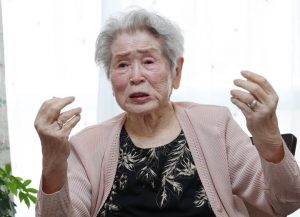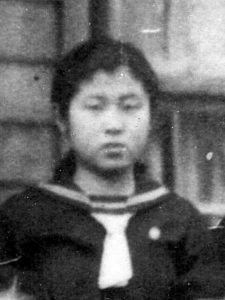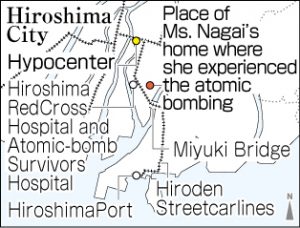Survivors’ Stories: Haruko Nagai, 95, Naka Ward, Hiroshima City – Atomic bombing eats away at both her body and mind
Jun. 13, 2023
by Rina Yuasa, Staff Writer
Memory of acute symptoms and lingering poor health prevented her from recounting her A-bombing experience for a long time.
Haruko Nagai experienced the atomic bombing when she was 17. Ms. Nagai hasn’t told of her experience of the bombing thus far because it has been so painful for her to recall the hell-like scene she saw on that day, as well as her acute symptoms and poor health conditions after the end of the war. However, now at 95 years old, she has a stronger wish to speak of the horribleness of nuclear war and war altogether before she dies.
In March 1945, Ms. Nagai graduated from First Hiroshima Prefectural Girls’ High School (present-day Minami High School). As her biological father died early from an illness, at the time, she lived with four members of her family: her stepfather, mother, and two young brothers, who were then seven and five years old.
On the morning of August 6, she was at home in Higashisenda-machi (now part of Naka Ward.) Suddenly, she saw a blue flash in the garden and then, her body was floated in the air and slammed down to the floor. Her home was located about 1.6 kilometers from the hypocenter. She gained consciousness soon after, and helped her mother and two young brothers, who had been trapped under a shelf collapsed get out.
Nobody in her family had any serious injury, but her polka-dotted dress she had worn then had holes only on all the black dots. “Heat and flush at that moment entirely destroyed Hiroshima,” she said.
The four went to Hiroshima Red Cross Hospital (now Hiroshima Red Cross Hospital and Atomic-bomb Survivors Hospital) to receive treatment for her youngest brother’s bleeding head to which some Mercurochrome was applied. Then, they fled to Miyuki Bridge. On their way, she saw many people who walked with both of their arms forward; their skin hanging like ropes, their whole bodies turned red with burns. With their red body and white eyeballs, they looked like a daruma doll, a traditional Japanese doll. At Miyuki Bridge, those who wanted to have some water dived into the river one after the other, and drowned.
Afterwards, she got on a rescue truck. She was then brought to Ujina Port (now Hiroshima Port), and made a transfer to a ship at the port, but she doesn’t remember which island she finally arrived at. Where she stayed was a place like an auditorium, and many severely-wounded victims died one after another. As many of surviving victims had severe burns, even their family members, who had come and find them, weren’t able to identify their faces.
She ate a small amount of rice porridge put inside a bamboo cylinder at the shelter. Her brothers were hungry. Looking for food, she visited a private home nearby. A resident just said to her, “Go home.” She said, “The resident must have felt scared as an unknown person wearing a tattered clothing showed up at entrance.” When she recalls that period in which she felt desolated, tears still well up in her eyes now.
Three days later, her stepfather, who had been away from home to engage in demolition of buildings for creating fire lanes, came to pick up his family. When she returned to home, nothing remained there. After the war ended, her family built a shack at the ruined site and also relied on their relative living in suburbs.
Her unforgettable memory is the day when she helped clear up ruins of her relative’s home in Hakushima (now part of Naka Ward). While she dug tableware out of ground by hand, she had bloody urine and feces, and had lost some of her hair. She said, “I had a fever, too. At that time, I didn’t know such symptoms were caused by my exposure to bomb radiation.” After the end of the war, she always felt dizzy, and suffered from poor health conditions, mental and physical, with unknown causes. When she was 23 years old, she tried to commit suicide. She said, “The atomic bombing is harmful both to my body and mind.”
She got married at age 29 and moved to Fukuyama in Hiroshima Prefecture due to her husband’s job transfer. Having struggled for survival, she gradually became forward-looking. She continued to work as an arbitrator at court and as a radio host. But she never tried to disclose her painful A-bombing memory to others. She was worried her experience of the atomic combing could affect her daughter or grandchild.
She began to think she wanted to share her experience when she was around 90 years old. Seven years ago, with determination to be engaged in recounting her experience in her hometown, she returned to Hiroshima. She finally gave up that hope because she had lost her health, but her will hadn’t changed.
Recently, she cannot cast her eyes away from the world news. She worries every day that a nuclear war may happen. To the junior writers, she said, “Whether or not a nuclear weapon is used again depends on young people.”
(Originally published on June 13, 2023)
Memory of acute symptoms and lingering poor health prevented her from recounting her A-bombing experience for a long time.
Haruko Nagai experienced the atomic bombing when she was 17. Ms. Nagai hasn’t told of her experience of the bombing thus far because it has been so painful for her to recall the hell-like scene she saw on that day, as well as her acute symptoms and poor health conditions after the end of the war. However, now at 95 years old, she has a stronger wish to speak of the horribleness of nuclear war and war altogether before she dies.
In March 1945, Ms. Nagai graduated from First Hiroshima Prefectural Girls’ High School (present-day Minami High School). As her biological father died early from an illness, at the time, she lived with four members of her family: her stepfather, mother, and two young brothers, who were then seven and five years old.
On the morning of August 6, she was at home in Higashisenda-machi (now part of Naka Ward.) Suddenly, she saw a blue flash in the garden and then, her body was floated in the air and slammed down to the floor. Her home was located about 1.6 kilometers from the hypocenter. She gained consciousness soon after, and helped her mother and two young brothers, who had been trapped under a shelf collapsed get out.
Nobody in her family had any serious injury, but her polka-dotted dress she had worn then had holes only on all the black dots. “Heat and flush at that moment entirely destroyed Hiroshima,” she said.
The four went to Hiroshima Red Cross Hospital (now Hiroshima Red Cross Hospital and Atomic-bomb Survivors Hospital) to receive treatment for her youngest brother’s bleeding head to which some Mercurochrome was applied. Then, they fled to Miyuki Bridge. On their way, she saw many people who walked with both of their arms forward; their skin hanging like ropes, their whole bodies turned red with burns. With their red body and white eyeballs, they looked like a daruma doll, a traditional Japanese doll. At Miyuki Bridge, those who wanted to have some water dived into the river one after the other, and drowned.
Afterwards, she got on a rescue truck. She was then brought to Ujina Port (now Hiroshima Port), and made a transfer to a ship at the port, but she doesn’t remember which island she finally arrived at. Where she stayed was a place like an auditorium, and many severely-wounded victims died one after another. As many of surviving victims had severe burns, even their family members, who had come and find them, weren’t able to identify their faces.
She ate a small amount of rice porridge put inside a bamboo cylinder at the shelter. Her brothers were hungry. Looking for food, she visited a private home nearby. A resident just said to her, “Go home.” She said, “The resident must have felt scared as an unknown person wearing a tattered clothing showed up at entrance.” When she recalls that period in which she felt desolated, tears still well up in her eyes now.
Three days later, her stepfather, who had been away from home to engage in demolition of buildings for creating fire lanes, came to pick up his family. When she returned to home, nothing remained there. After the war ended, her family built a shack at the ruined site and also relied on their relative living in suburbs.
Her unforgettable memory is the day when she helped clear up ruins of her relative’s home in Hakushima (now part of Naka Ward). While she dug tableware out of ground by hand, she had bloody urine and feces, and had lost some of her hair. She said, “I had a fever, too. At that time, I didn’t know such symptoms were caused by my exposure to bomb radiation.” After the end of the war, she always felt dizzy, and suffered from poor health conditions, mental and physical, with unknown causes. When she was 23 years old, she tried to commit suicide. She said, “The atomic bombing is harmful both to my body and mind.”
She got married at age 29 and moved to Fukuyama in Hiroshima Prefecture due to her husband’s job transfer. Having struggled for survival, she gradually became forward-looking. She continued to work as an arbitrator at court and as a radio host. But she never tried to disclose her painful A-bombing memory to others. She was worried her experience of the atomic combing could affect her daughter or grandchild.
She began to think she wanted to share her experience when she was around 90 years old. Seven years ago, with determination to be engaged in recounting her experience in her hometown, she returned to Hiroshima. She finally gave up that hope because she had lost her health, but her will hadn’t changed.
Recently, she cannot cast her eyes away from the world news. She worries every day that a nuclear war may happen. To the junior writers, she said, “Whether or not a nuclear weapon is used again depends on young people.”
(Originally published on June 13, 2023)










